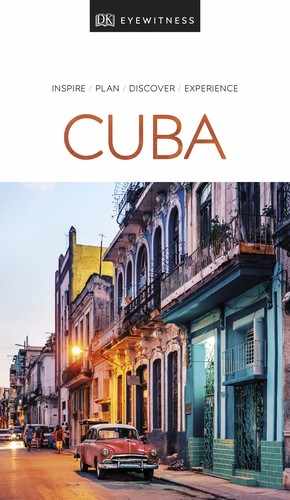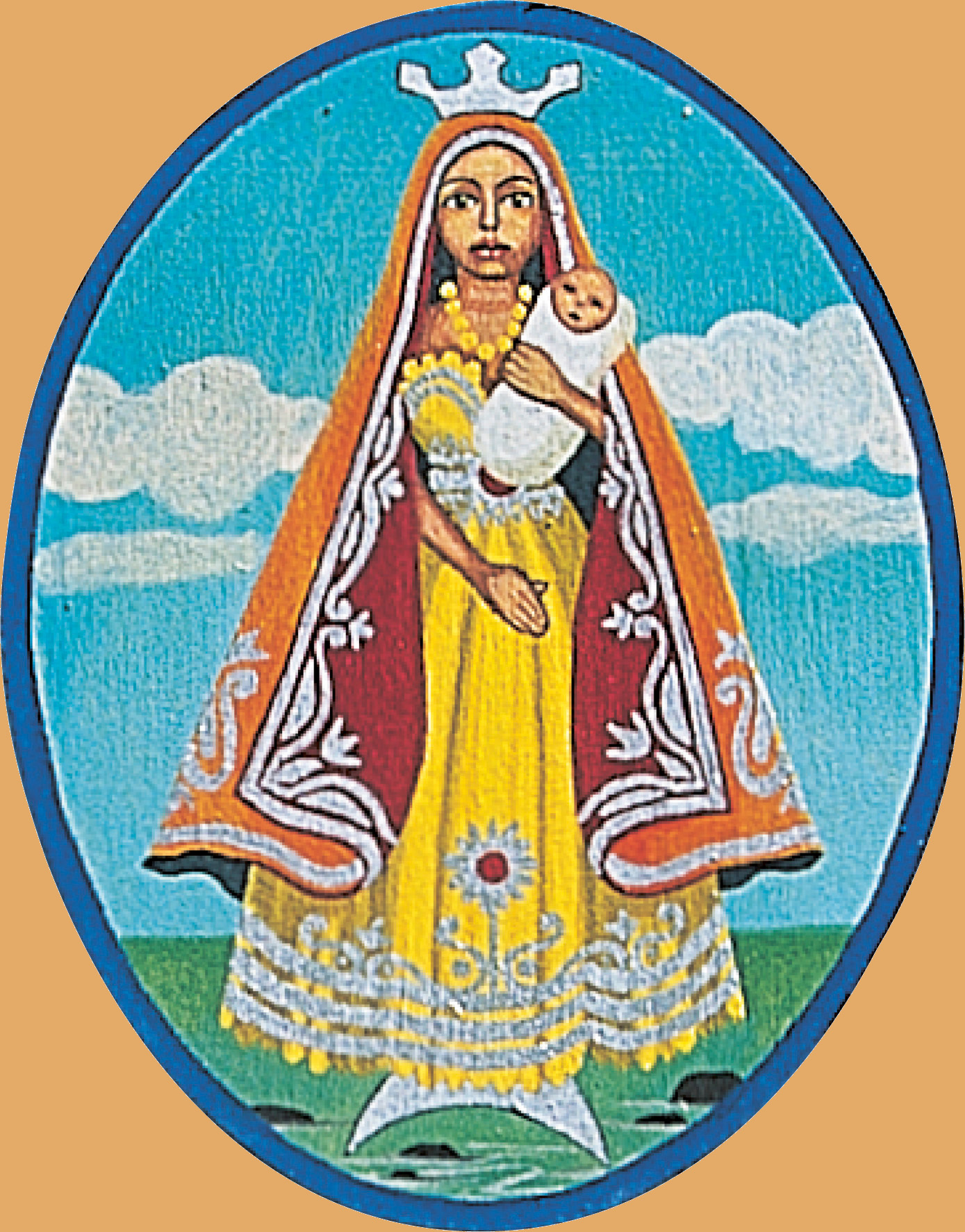experience more
Completed in 1741 for the royal treasurer Diego Peñalver y Angulo, this sombre Baroque mansion on the southeast corner of Plaza de la Catedral reopened in 2017 as a cultural centre following an extensive restoration. Check out the original cistern in the patio before climbing the staircase, which is painted with colonial-era motifs, to rooms displaying historical lithographs and exquisite mediopunto stained-glass windows.
A life-size bronze statue of Spanish flamenco dancer Antonio Gades (1936-2004) leans against a pillar facing the plaza. Although the building can be entered from this plaza, the main entrance – flanked by Doric pilasters – is on Calle Mercaderes. Here, you’ll find a letter box in the form of a Greek tragic mask, recalling the building’s illustrious past as both a post office and, later, the city’s Artistic and Literary Lyceum. The name of the palace’s café also reflects this erstwhile function.
Did You Know?
The Catedral de San Cristóbal’s bell towers are asymmetrical because of a lack of space.

t The cobbled square in front of the Catedral de San Cristóbal
Havana’s cathedral had a tumultuous beginning. Construction of the Catedral de San Cristóbal (Cathedral of St Christopher) began in 1748 under the supervision of Jesuit priests. Expelled from Cuba following conflict with the Spanish crown, the
Jesuits were replaced by Franciscans, who finished the church in 1777. It became a cathedral after the collapse of the old Parroquial Mayor (main parish church), which was caused by the explosion of a ship in the nearby port. With its newfound status, it required an additional bell tower.
In 1789, it was consecrated as Catedral de la Virgen María de la Inmaculada Concepción, but in 1796 it was given its current name because, according to popular belief, from that year until 1898 it housed the remains of Christopher Columbus. A plaque to the left of the pulpit tells the same story, though there is no official historical record.
The architecture, like other Jesuit churches throughout the world, is in a Latin cross layout, chapels on the sides and to the rear, the nave higher than the side aisles. The Cuban Baroque façade is grandiose, with its two large, bell towers and an abundance of niches and columns, which Cuban author Alejo Carpentier described as “music set in stone”.
By comparison, the Neo-Classical interior is rather disappointing. Large piers separate the nave from the aisles, which have eight chapels. The largest is the Sagrario chapel, while the oldest was designed by Lorenzo Camacho in 1755 and is dedicated to the Madonna of Loreto. Inside, the quaint, tiny houses are used as ex votos (offerings to saints).
The three frescoes behind the high altar are by Giuseppe Perovani, while the wooden and plaster ceiling was the work of Frenchman Jean Baptiste Vermay, who founded the San Alejandro Fine Arts Academy. The high altar was created by Italian artist Giuseppe Bianchini in the 1800s. To the right is a huge wooden statue of St Christopher, carved by the Seville sculptor Martín de Andújar in 1636. The legs are out of proportion with the trunk, as they were cut in order to allow the statue to pass through the portal.
On 16 November, the saint’s feast day, a solemn Mass is held here, during which the faithful file past the statue to silently ask for his blessing, which is given as long as they do not utter a word until they have left the church.

Hidden Gem
Mural Artístico-Histórico
Facing the Palacio del Marqués de Arcos, this mural features life-size representations of 67 leading 19th-century Cuban literary figures, including José Martí.

t The historic blue-and-yellow courtyard of the Museo de Arte Colonial
This 18th-century mansion, built by Don Luis Chacón, governor of Cuba, has since 1969 been the home of a museum dedicated to colonial art. Constructed around an elegant courtyard, the building is a fine example of a colonial home.
The 12 rooms on the ground floor and first floor contain furniture, chandeliers, porcelain and other decorative pieces from various 18th- to 19th-century middle-class and aristocratic houses in Havana, combining European, Creole and colonial traditions. Besides a remarkable collection of furniture made of tropical wood, the museum has an exceptional collection of stained-glass windows (mediopunto), typical of Cuba’s Creole artisans.
There is also a thirteenth room in which contemporary art and crafts exhibitions, inspired by colonial art, are held. During the week the museum conducts tours for the city’s schoolchildren and offers various leisure activities for the elderly.
Experience La Habana Vieja
|
EAT Mama Inés Fidel’s former private chef conjures up superb fusion dishes in a colonial mansion. W2 ⌂ Calle de la Obra Pía, 60 § 7862 2669 ¢ Sun \ Doña Eutimia This intimate family-run restaurant serves criolla classics. V2 ⌂ Callejón del Chorro, 60C § 7861 1332 ¢ Sun \ El del Frente You can either enjoy tapas and mojitos on the roof terrace or inside the 1950s-inspired interior at this paladar. V2 ⌂ Calle O’Reilly, 303 § 7863 0206 \ Azúcar Overlooking Plaza Vieja, Azúcar provides light meals and live music. W3 ⌂ Calle Mercaderes, 315 § 7801 1563 \ |
This fortress (castillo) was built in 1558–77 to protect the city from pirate attacks, following a raid by the French buccaneer Jacques de Sores in 1555, in which the original fort was destroyed and Havana devastated. Despite its moat and thick walls, the castle soon proved to be quite inadequate as a defensive bulwark because of its poor strategic position, too far inside the bay. Consequently, the castle became the residence of governors, military commanders and leading figures, as well as a safe place to store treasures brought from America and en route to Spain.
In 1634, a weathervane known as La Giraldilla was placed on the lookout tower, which soon became the symbol of Havana. The original is on display in the entrance and a copy has been placed on the tower. In 1851, part of the fortress’s façade was demolished to enable Calle O’Reilly to be extended to the waterfront. This street was named for Alejandro O’Reilly, an Irishman who became a Spanish military commander in the 18th century and who advised King Carlos III of Spain on improving Havana’s defences after the British invasion of 1762.
Today, the fortress houses a shipwreck museum with displays of artifacts, jewels and a large model of the naval ship Santísima Trinidad.
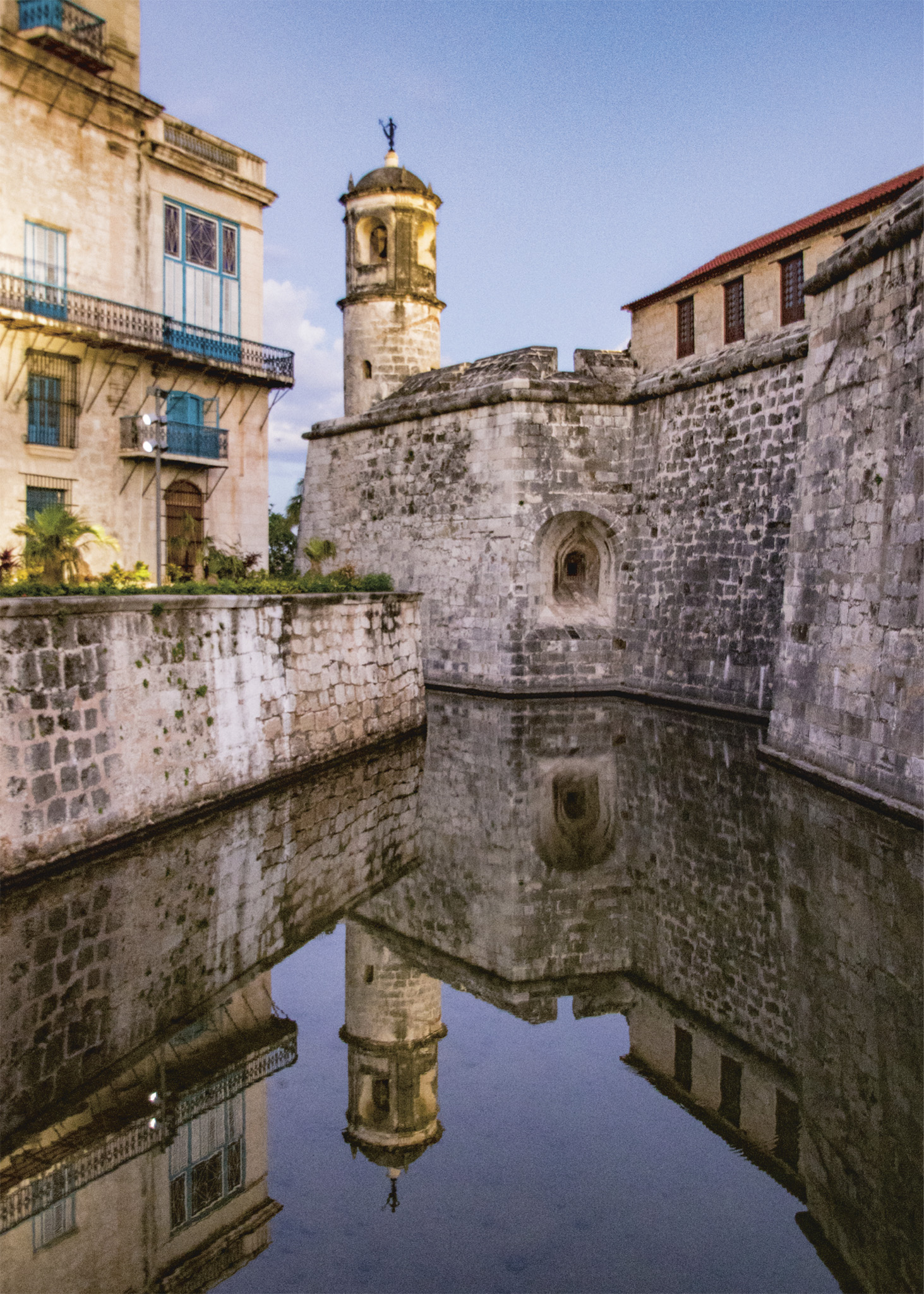
t The moat encicling the 16th-century Castillo de la Real Fuerza

t A traditional live music performance at La Bodequita del Medio
Standing exactly at the halfway point in a typical small street in old Havana, a few steps away from the cathedral, La Bodeguita del Medio (literally, “little shop in the middle”) has become a big attraction.
The bodega was founded in 1942 as a place for the local population to trade rice, beans, sugar and other goods. A bar serving alcoholic drinks was added and the place became a haunt for intellectuals, artists and politicians. Today it is no longer a shop but a bustling bar at the front serves shots of rum and Cuban cocktails and a good restaurant hidden in the back offers typical Creole dishes. Take the time to admire the walls of the iconic bar, which are plastered with photographs, drawings, graffiti and visitors’ autographs, including those of famous patrons such as the singer Nat King Cole, poets Pablo Neruda and Nicolás Guillén, and the writers Gabriel García Marquez, Alejo Carpentier and Ernest Hemingway, who was a regular here. You’ll find a note on the wall, supposedly from the American author, proclaiming “My Mojito in La Bodeguita; My daiquiri in El Floridita”. Unfortunately, it is a forgery and the slogan in fact originated as a marketing ploy dreamt up by the owners of La Bodeguita del Medio in the 1950s. Despite it’s inauthenticity, the classic drink to order here is still the “Hemingway Mojito”.

Picture Perfect
Local Life
In Havana’s plazas you will often see women in full-length traditional costumes carrying floral baskets. Licensed by the City Historian’s Office, they will pose for photographs in exchange for tips.
This building was erected by the Jesuits in the mid-18th century to house a seminary first founded in 1689. Famous Cuban intellectuals and patriots studied here, including Padre Félix Varela (1788–1853), who laid down the theoretical bases for the Cuban war of independence. The Catholic cultural centre that now occupies the building takes its name from this Cuban hero.
The large central courtyard is the only one of its kind in Cuba: it has galleries on three levels, the first with simple columns, the second with double columns and the third with plain wooden piers.
The ornate inner stairway leading to the first floor has trapezoidal motifs instead of the more common arch, and fine black mahogany banisters.

t The unassuming Neo-Classical exterior of El Templete
Small and austere, this Neo-Classical building, resembling a temple, stands on the spot where, legend has it, the city was founded in 1599. Here, under a leafy ceiba – a tropical tree considered sacred by all natives of Central America – the first meeting of the local government and the first Mass reputedly took place. A ceiba still stands in front of El Templete, although it is not the original. Next to it is the Columna de Cacigal, named after the governor who had it built in 1754.
El Templete, completed in 1828, was modelled after a monument in the town of Guernica in northern Spain. Inside are three huge canvases by Jean-Baptiste Vermay, depicting scenes from the history of Havana.
Experience La Habana Vieja
|
STAY Hotel Santa Isabela A palatial hotel in an unbeatable location. W2 ⌂ Calle Baratillo, 9 ∑ gaviotahotels.com \ Casa Vitrales You’ll find eclectic furnishings and a superb rooftop breakfast here. U2 ⌂ Calle Habana, 106 ∑ cvitrales.com \ Loma del Ángel This chic casa particular has two suites. V2 ⌂ Calle Cuarteles, 104 ∑ lomadelangel.com \ |

t Life-size statue of El Caballero de París, by José Villa Soberón (2001), on Calle Oficios
One of the capital’s oldest streets, Calle Oficios is among only four in existence from the end of the 16th century. It was originally a link between the military centre of Plaza de Armas and Plaza de San Francisco, the city’s commercial hub. Together with Calle Obispo, this is one of the most atmospheric streets in Old Havana and most of the façades date from the 18th and 19th centuries.
The street is bisected by the Plaza de San Francisco. At the intersection you will find a bronze statue of El Caballero de París (The Gentleman of Paris), who roamed Havana’s streets in the 1950s engaging passersby in discussions about philosophy and politics. North of the plaza is the 18th-century Casa de los Arabes. It displays 18th- and 19th-century Hispanic-Arab bronzes, fabrics, rugs and furn-iture in three permanent and two temporary exhibitions rooms. This ethnographic display of Arab objects serves as evidence of the presence of an old Lebanese, Syrian and Palestinian colony in Cuba.
South of Plaza de San Francisco is the Coche Mambí, a handsome green-and-white train coach dating from 1900. For several decades from 1912, it served as the official railway accommodation for presidents of Cuba. Visitors can board to look at the plush reception room, dining rooms and lounge, which all have dark wood panelling, and the neatly fitted bedroom and kitchen.
Casa de los Arabes
⌂ Calle Oficios, 16 § 7801 1868 # 9:30am– 5pm Tue–Sat, 9:30am–1pm Sun
Coche Mambí
" ⌂ Calles Oficios y Churruca # 9:30am–5:30pm Tue–Sat, 9:30am–1pm Sun
Did You Know?
The Mezquita Abdallah (Calle Oficios, 18) is the only mosque in Cuba. Only Muslims may enter it.

t Tables in front of the Taquechel pharmacy on Calle Obispo
The liveliest and most characteristic street in La Habana Vieja is like a long, narrow bridge linking the two architectural souls of the historic centre, the colonial and the Art Nouveau-eclectic. At one end is the Plaza de Armas, the Cuban Baroque heart of the old city, while at the other is Avenida Bélgica and the famous El Floridita restaurant, marking the start of the more modern district. The street name comes from the residence of the city bishop (obispo), on the corner of Calle Oficios.
Restoration work promoted by the Oficina del Historiador de la Ciudad has salvaged the best buildings, so Calle Obispo retains the elegance, vivacity and colours of the colonial period. There is plenty to see on an afternoon stroll here: No 117–19 is the oldest house in Havana, and there’s also the small Casa del Agua la Tinaja, which for centuries has been dispensing well water purified by very old but still efficient ceramic filters. Here, you’ll find a plaque on the left-hand side of the Palacio de los Capitanes Generales, bearing quotations made by the great Cuban patriot José Martí concerning Garibaldi’s stop at Havana.
Don’t miss the fascinating Taquechel, an old pharmacy which sells cosmetics and natural and homeopathic products, all created and produced in Cuba. Quaint shelves hold a collection of pretty 17th- and 18th-century glass and Italian majolica jars, alembics and antique objects.
One of the major sights in the street is the restored Hotel Ambos Mundos. This eclectic hotel is rich in literary links. Hemingway stayed here for long periods from 1932 to 1939, and began writing For Whom the Bell Tolls in room 511.
El Floridita restaurant is known as “the cradle of the daiquirí”. Here, in the 1930s, barman Constante (real name Constantino Ribalaigua) perfected the original recipe. The new-style cocktail, a blend of white rum, lemon, sugar and a few drops of maraschino and ice, was devised with the help of Ernest Hemingway, who was a regular. Today, in luxurious El Floridita, besides Constante’s classic cocktails you can feast on lobster and other shellfish in the company of a bust of the great novelist, sculpted by Fernando Boada.
Casa del Agua la Tinaja
⌂ Calle Obispo, 111 # 10am–7pm daily
Taquechel
⌂ Calle Obispo, 155 # 9am–4:30pm daily
Hotel Ambus Mundos
⌂ Calle Obispo, 153 ∑ gaviotahotels.com
El Floridita
⌂ Calle Obispo, 557 ∑ floridita-cuba.com
Experience La Habana Vieja
|
shop Habana 1791 This perfumery sells traditional fragrances. V2 ⌂ Calle Mercaderes, 176 § 7861 3525 ¢ Sun pm Centro Cultural Almacenes de San José Havana’s largest artisan market. W4 ⌂ Av de los Desamparados y Calle San Ignacio § 7864 7793 Museo de Chocolate Artisan confectionary is for sale here. W3 ⌂ Calle Mercaderes, 251 § 7866 4431 |
Curling north to south through the heart of the restored quarter between Plaza de la Catedral and Plaza Vieja, narrow Calle Mercaderes (Street of Merchants) is lined with little museums and shops. It is home to the Mural Artístico-Histórico, as well as the Maqueta de Centro Histórico, which houses a scale model of Habana Vieja, and the Museo del Tabaco.
On the next block, the Armería 9 de Abril museum recalls an assault by Fidel’s revolutionaries on this former gun shop.

t Customers sampling fragrances at Habana 1791 on Calle Mercaderes
Maqueta de Centro Histórico
" ⌂ Calle Mercaderes, 116 # 9am–6pm daily
Museo del Tabaco
⌂ Calle Mercaderes, 120 # 10am–5pm Mon–Sat
Armería 9 de Abril
⌂ Calle Mercaderes, 157 # 1–5pm Mon, 9am–5pm Tue–Sat
Calle Obra Pía (literally Charity Street) was named after this mansion, which earned its monicker from the pious actions of Martín Calvo de la Puerta y Arrieta. A wealthy Spanish nobleman, he lived here in the mid-17th century and gave an annual dowry to five orphan girls. A century later the residence became the home of Don Agustín de Cárdenas, who was elevated to marquis for taking Spain’s side in 1762 during the British occupation. A jewel of Cuban Baroque architecture, its upper rooms have colonial furnishings and ornaments.
The mansion also houses a museum of sewing machines and an art gallery.
At the corner of calles Obra Pía and Mercaderes is the Casa de México, a cultural centre reflecting the close links between Mexico and Cuba. It has a library and a museum with handmade glass, silver and other objects. Opposite is the Casa de Guayasamín, which displays works by the Ecuadorean painter Oswaldo Guayasamín (1919–99).
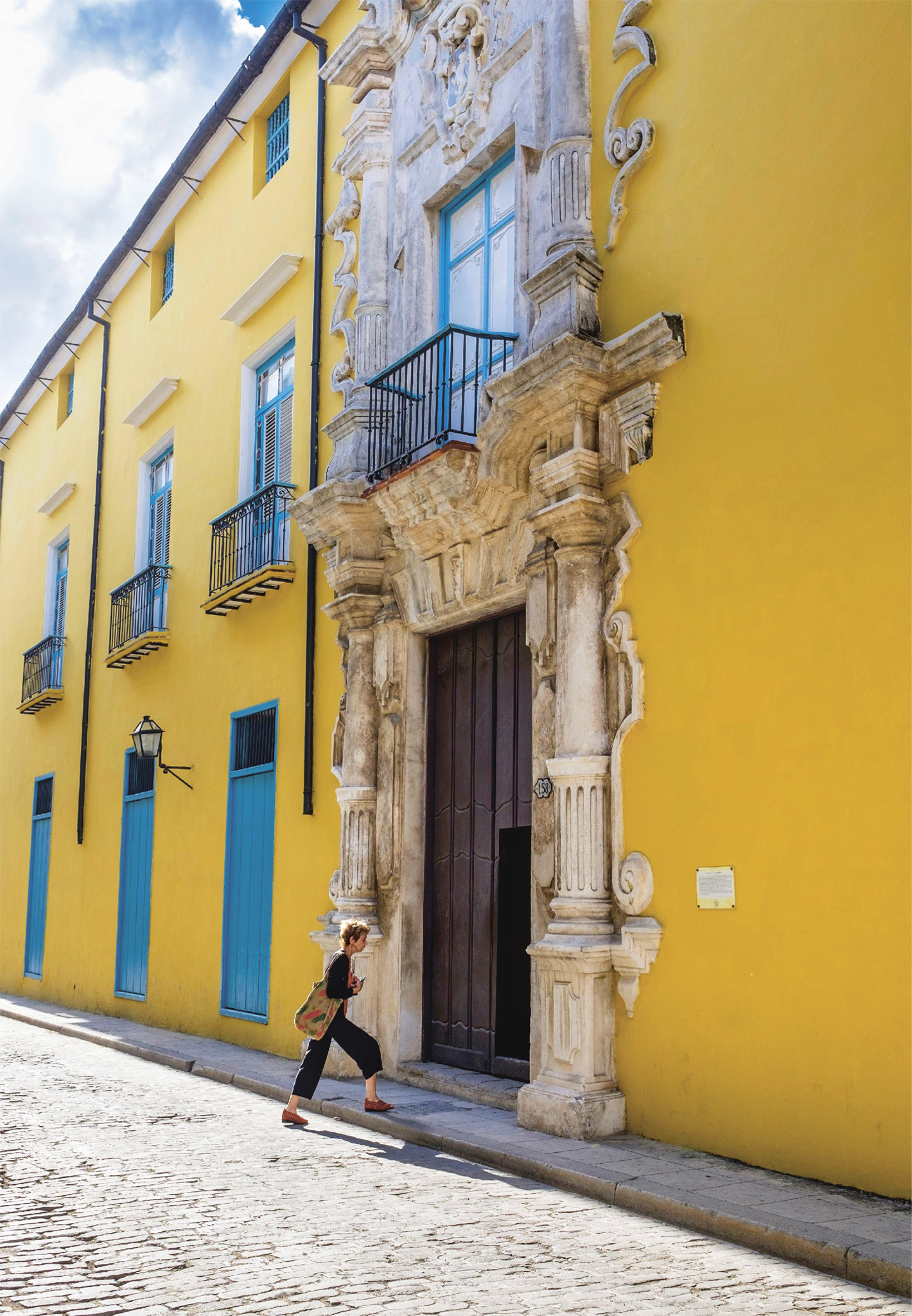
t The yellow façade of Casa de la Obra Pía, with its turquoise windows
Casa de México
" V2 ⌂ Calle Obra Pía, 116 § 7861 8166 # 9am–2:30pm Tue–Sun
Casa de Guayasamín
W2 ⌂ Calle Obra Pía, 112 § 7861 3843 # 9am–4:30pm Tue–Sun
Opposite the Casa de la Obra Pía is a 17th-century building, rebuilt in 1887 to house a family of plantation owners on the upper floor and a tobacco factory, worked by slaves, below. The building is now a museum containing more than 2,000 objects linked to the history of sub-Saharan Africa and the various ethnic groups taken into slavery. Many items belonged to the ethnographer Fernando Ortíz, a specialist in the African roots of Cuban culture. The museum includes sections on Afro-Cuban religions and batá drums, as well as a library.

t A restaurant, shaded beneath one of the arcades on Plaza Vieja
Laid out in 1559, this square was originally called Plaza Nueva (New Square). In the 19th century, after further city development, it lost its role as the city’s main square and was renamed, but has since been restored to its original look.
Plaza Vieja is surrounded by arcades and several historic buildings from four centuries. In the middle of the square, you’ll find the surreal Viaje Fantástico statue, as well as a replica of a fountain dating from 1796.
Don’t miss the Casa de los Condes de Jaruco. This mansion was once the home of the Countess de Merlin, a Cuban romantic novelist who also wrote a travel book about Cuba. The edifice of the building is a fusion of Baroque and Spanish Moorish styles. Today, it houses an art gallery.
On the corner of calles Muralla and Mercaderes is the eye-catching Art Nouveau Hotel Palacio Cueto, which was built in 1908. On the east side of the plaza, the Planetario has high-tech interactive exhibits, while Fototeca de Cuba holds photographic exhibitions. La Factoria Plaza Vieja, on the southwest corner, is a lively brewpub.
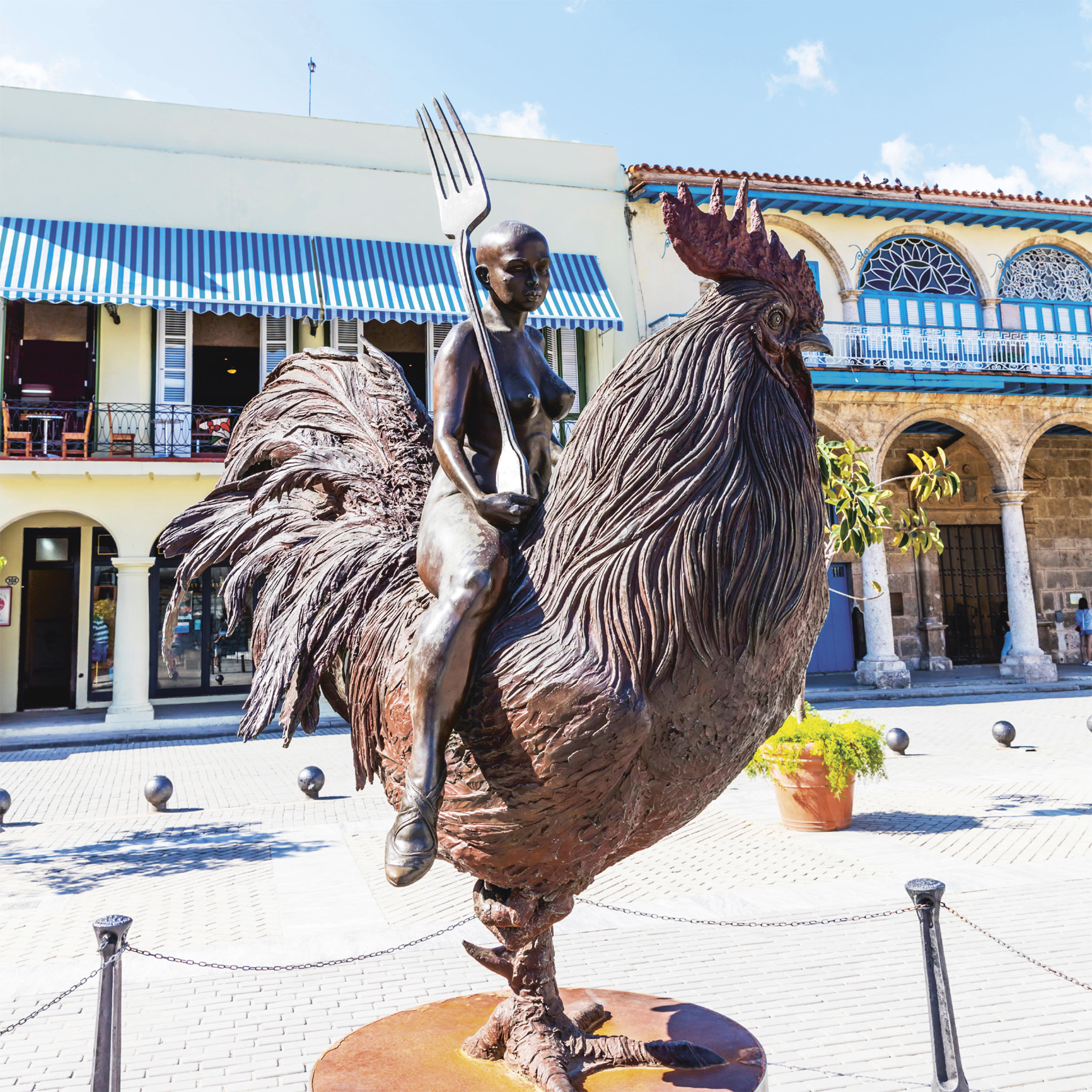
t Roberto Fabelo’s Viaje Fantástico (2012) on Plaza Vieja, showing a woman riding a cockerel
Casa de los Condes de Jaruco
V3 § 7862 2633 # Daily
Planetario
" W3 ⌂ Calle Mercaderes, 311 e/Teniente Rey y Muralla # 10am–3:30pm Wed–Sun
Fototeca de Cuba
W3 ⌂ Mercaderes, 307 e/Teniente Rey y Muralla # 10am–5pm Tue–Sat
La Factoria Plaza Vieja
V3 ⌂ San Ignacio y Muralla # 11am–midnight daily

Great View
Real-Life Movie
For a sweeping view of La Habana Vieja ascend to the rooftop of Edificio Gómez Villa on Plaza Vieja. Here, a Cámara Oscura (a revolving peep-hole camera) projects a real-time panorama onto a screen.
Experience La Habana Vieja
SANTERÍA

t A Santería altar with Christian, secular and personal offerings

t An offering during a Santería ritual taking place on a Cuban street
Different religions co-exist in Cuba as the result of its history. Both the Roman Catholicism of the Spanish conquerors and the practices of the African slaves have survived. The most widespread of the African faiths is Santería.
SANTERÍA’S BELIEFS
Also called Regla de Ocha, Santería (Way of the Saints) is based on the beliefs of Yoruba slaves, with some additional Christian elements. The main Santería god is Olofi, the creator divinity, similar to the God of Christianity but without contact with Earth. The gods who mediate between him and the faithful are the orishas, who listen to the latter’s prayers.
Experience La Habana Vieja
THE ORISHAS
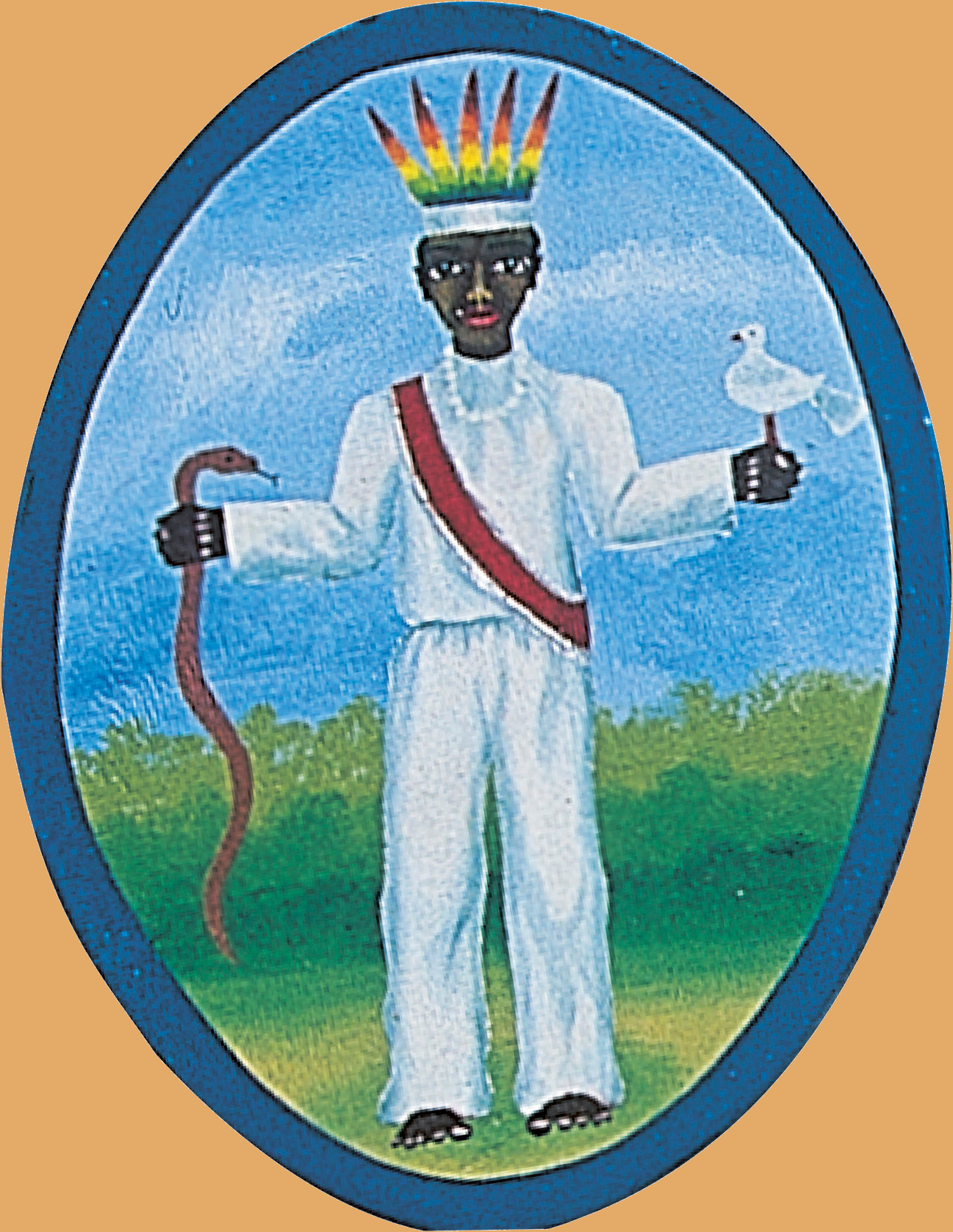
Obatalá
A hermaphrodite god and the chief intermediary between Olofi and humankind.

Yemayá
The sea goddess and mother of orishas wears blue. She is capable of both great sweetness and great anger, and is linked with the Virgen de la Regla.
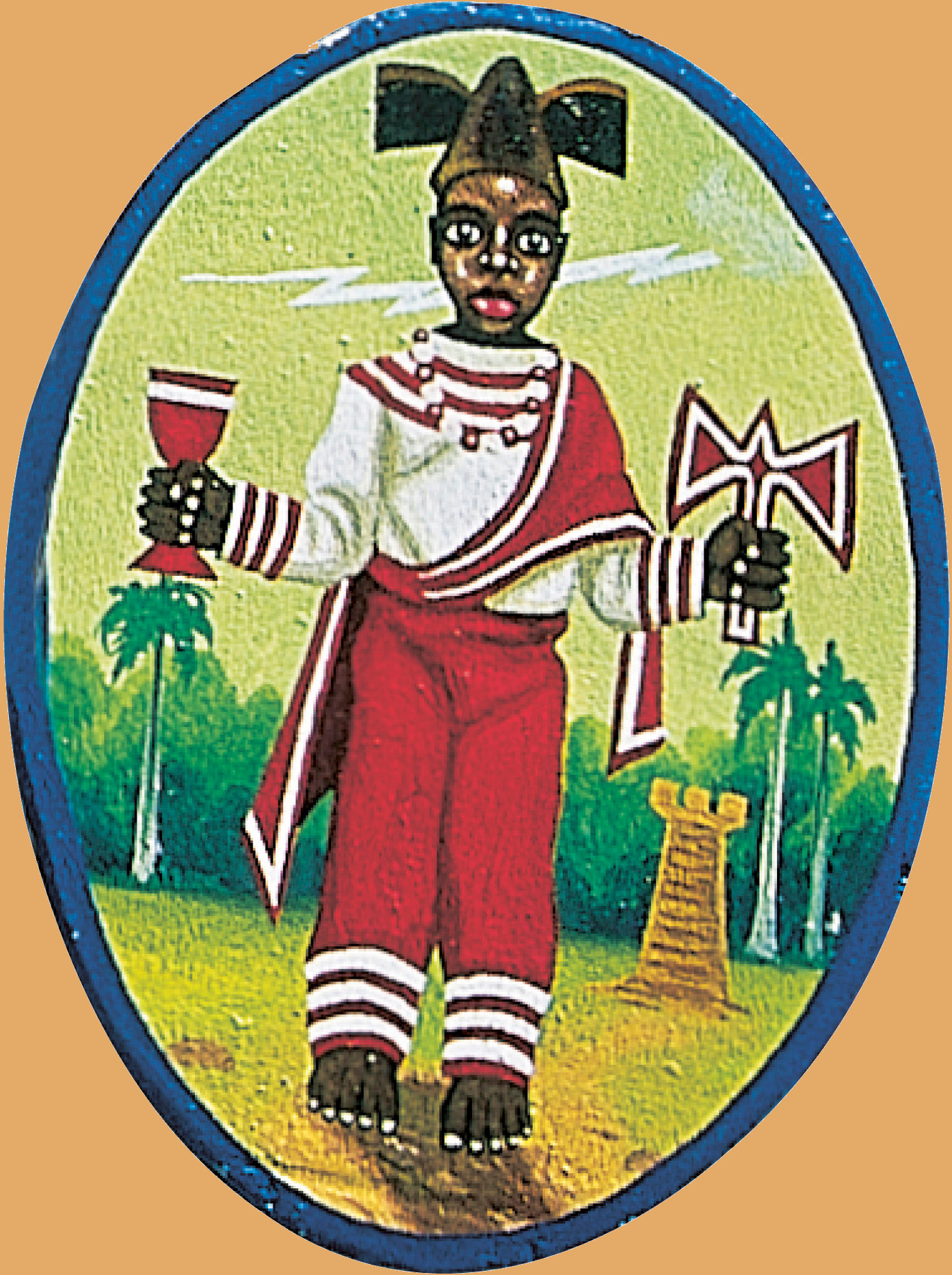
Changó
The virile and sensual god of fire and war adores dancing and corresponds to St Barbara.
Construction of this church began in 1637 but ended only in the following century, while the lavish decoration of the interior dates from the 19th century. The church is popular among those who follow Santería, a local Afro-Cuban religion. According to their beliefs, Our Lady of the Merced corresponds to a Yoruba divinity, known as Obatalá, principal figure among the gods and the protector of mankind, who imparts wisdom and harmony.
Did You Know?
On 24 September, worshippers come to Iglesia de Nuestra Señora de la Merced dressed in white.
The Church of the Holy Ghost (Espíritu Santo) is one of the oldest Roman Catholic churches in Havana. It was built in 1637 by freed African slaves. Thanks to a papal bull and a royal decree from Carlos III, in 1772 it acquired the exclusive right to grant asylum to all those persecuted by the authorities.
From an architectural standpoint, the building’s most striking feature is the extremely tall tower. The church was radically rebuilt in the 19th century, and it retained the Hispanic-Arab look, which once defined the building, only in the characteristic double pitch roof.
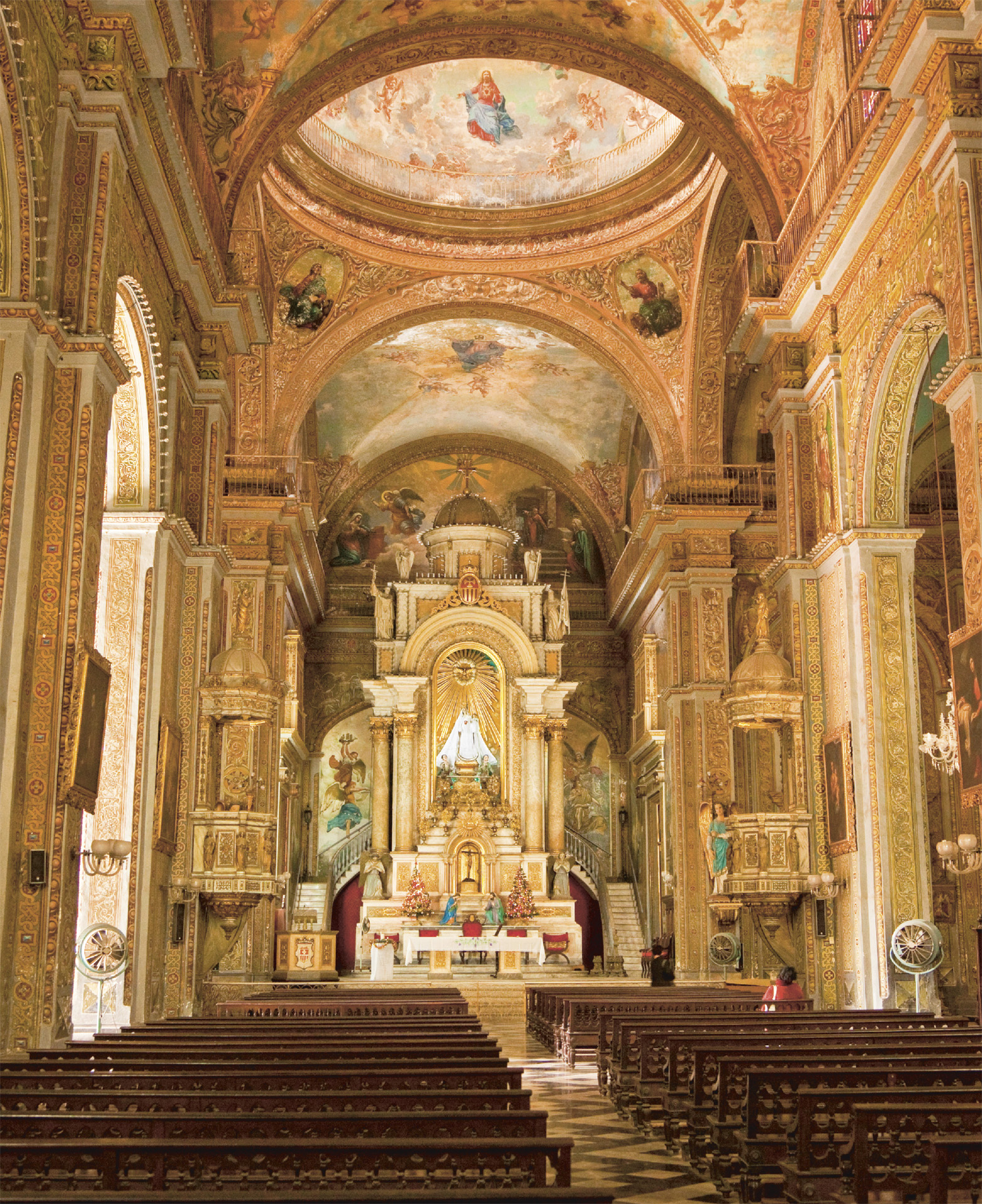
t Rich decoration in the nave of the Iglesia de Nuestra Señora de la Merced
This modest 19th-century building in the Paula quarter became a national monument thanks to the importance attached to José Martí, the object of great patriotic veneration. The author and national hero, who died in combat on 19 May 1895 during the wars of independence against the Spanish, was born here in 1853. After his death his mother, Leonor Pérez, lived here and when she died it was rented to raise money to bring up her grandchildren. In 1901, it was bought by the municipality after city-wide fundraising, and became a museum in 1925.
The historic house has been beautifully restored and faithfully furnished, and contains paintings and first editions of the writer’s works. Objects of great historic value include the inkpot and ivory pen used by Máximo Gómez and José Martí to sign the Manifesto de Montecristi, marking the beginning of the war against Spain. Everyday objects include the penknife Martí had in his pocket when he died, and the album with dedications and signatures from friends on his marriage to Carmen Zayas-Bazán.

t Plaza de San Francisco, with its imposing basilica and ornate fountain
Bordering the port, this picturesque square has an Andalusian character and evokes images of a distant age when galleons loaded with gold and other cargo set sail for Spain. In the middle of the square is the Fuente de los Leones, modelled on the famous fountain in the Alhambra in Granada. This work by the Italian sculptor Giuseppe Gaggini was donated in 1836 by the fiscal superintendent, Don Claudio Martínez de Pinillos, Count of Villanueva, and for many years it supplied the ships docked here with drinking water.
The original commercial nature of the area can be seen in two buildings: the Aduana General de la República (the old customs house), built in 1914, and the Lonja del Comercio (the former stock exchange, 1908), with a dome crowned by a statue of Mercury, the Roman god of commerce. It houses the offices of some of the top foreign firms now operating in Cuba.
The most important building in the square by far, however, is the Basílica Menor y Convento de San Francisco de Asís, built in 1580–91 as the home of the Franciscan community and partly rebuilt in the 1700s. The three-aisle interior has a Latin cross layout and contains a wooden statue of St Francis. The basilica also holds the remains of major Havana citizens, including the Marquis González, who died during the British siege of 1762.
Because of its exceptional acoustics, this church has been converted into a concert hall for choral and chamber music every Saturday at 6pm.
In the cloister and rooms of the adjacent monastery, which dates back to 1739, is a museum of holy art with 18th- to 19th-century missals, votive objects and 16th- to 18th-century ceramics.
Basílica Menor y Convento de San Francisco de Asís
" ' § 7801 2524 # 9:30am– 4:30pm Tue–Sat ¢ 1 Jan, 1 May, 26 Jul, 10 Oct, 25 Dec
Did You Know?
The railway line along the harbourfront is only used by an antique steam train hauling tourists.
The manufacture of Havana Club, the most famous brand of Cuban rum, is explored at this museum. Visuals and models explain the production process of the spirit described as the “cheerful child of sugar cane” by Cuban writer Fernando Campoamor.
The tours begin in the courtyard of the Havana Club Foundation. After watching a brief film about sugar cane, visitors see exhibits that explain the fermentation, distillation, filtration, blending and bottling processes. The central hall has a fascinating model of an ingenio (sugar plantation), including a miniature steam train. Tours end in a bar where visitors can relax and sample three-year-old rum and cocktails made from younger bottles of rum. There’s often live music here too.
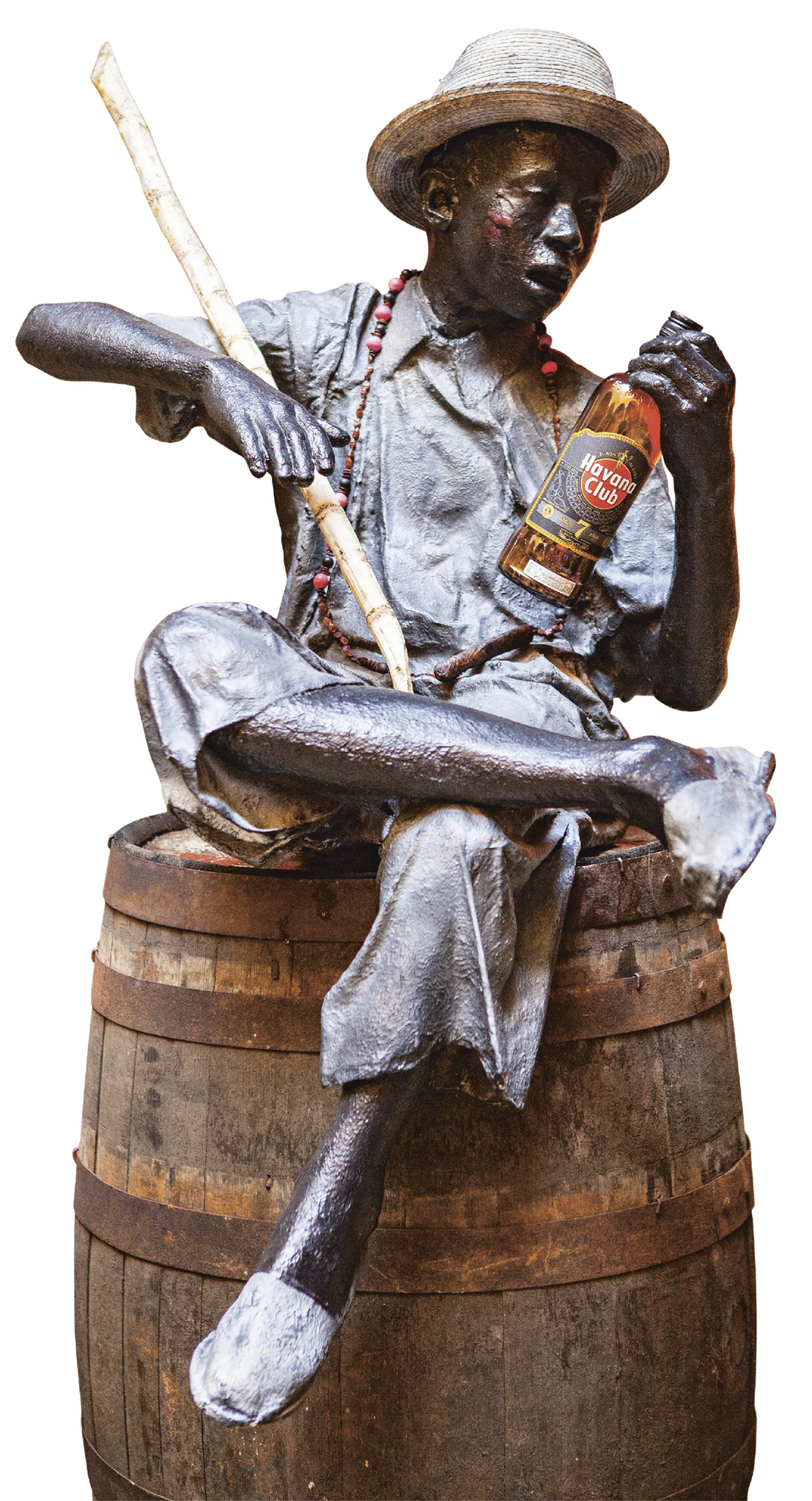
t An enchanting statue in the courtyard of the Museo del Ron

t Gold-leaf murals in the Catedral Ortodoxa Nuestra Señora de Kazán
Surrounded by Spanish colonial buildings, the Russian Orthodox Our Lady of Kazán Cathedral rises incongruously over the waterfront. Built to a classical Byzantine design, it features voluptuous cupolas capped in bronze and an interior adorned with gold-leaf-backed murals.
Completed in 2008, its construction was funded by the Soviet Embassy to symbolize Cuban-Russian friendship. It serves the Russian Orthodox offspring of Soviet personnel who once lived in Cuba.

Insider Tip
Ferry Tale
Hop on the funky lancha (ferry) that runs between the Emboque de Luz terminus and Regla for a fabulous vista of the Havana waterfront. It costs a mere 20 centavos (you’ll need peso cubano).
This short waterfront promenade forms part of the rebirth of the Havana bayside area. With trees, benches and balustrades, the promenade is marked at its southern end by the small Iglesia de Paula, once the chapel of a 17th-century hospital. Today, it hosts classical music concerts. Across the road is Havana’s largest craft market, the Antiguo Almacenes San José.
Nearby, the waterfront Museo del Automóvil has an eclectic selection of vehicles, including a Bel-Air Chevrolet once owned by Che Guevara.
Museo del Automóvil
' " ⌂ Avenida del Puerto # 9:30am–4:30pm Tue–Sat, 9am-1pm Sun ¢ 1 Jan
An astounding example of Art Deco architecture, the former headquarters of the Bacardi rum corporation is a classic Havana landmark and, on completion in 1930, was the city’s tallest building.
Designed by Cuban architect Esteban Rodríguez, the stunning 12-storey edifice was constructed with two-tone pink Bavarian granite. The structure is further adorned with glazed terracotta motifs depicting naked nymphs by the American artist Maxfield Parrish, known for his Neo-Classical influences.
Inside, the lobby is clad entirely with triple-tone European marble, symbolizing Bacardi’s white, gold and dark añejo rums, and features etched glass, gold leaf and ornamental brass in which bats – the Bacardi symbol – feature prominently. A giant bronze bat is perched on top of the Mesopotamian-inspired bell tower too.
Appearing as if made of Lego® bricks, the building, which was renovated in 2001 by the Office of the Historian of the City, currently houses various offices and is not open to the public except for the Café Barrita. This wood-panelled mezzanine bar overlooks the exuberant foyer and was frequented by socialites in the 1950s. Just don’t expect to be able to buy a Bacardi rum here! As a leading supporter of the US embargo, the company is derided in Cuba.
A small tip to the staff in the lobby will grant you access to the rooftop, which offers amazing views over the cityscape of Havana.

t The Art Deco interior of Edificio Bacardí, an iconic Havana landmark
This lovely little church occupies the Plazuela de Paula, at the southern end of the Alameda de Paula. Built in 1745, the church was originally in the shape of a Latin cross, with an octagonal cupola, and was attached to a women’s hospital. The latter was demolished in 1907 by the Havana Railroad Company but the church, despite its grave disrepair, was saved from demolition by a popular public outcry.
The pre-Churrigueresque (late Spanish Baroque) façade is adorned with pilasters, with alcoves containing statues, and topped by a triple bell-cot. It also features beautiful vitrales (stained-glass windows) by prominent Cuban artists Nelson Domínguez and Rosa María de la Terga. The bright interior is also enhanced by a permanent collection of works of art by other significant contemporary artists.
The church, which has a fine 19th-century organ, is today Havana’s premier venue for concerts of ancient and sacred music.

Hidden Gem
Plaza del Cristo
Long overlooked by visitors, this restored plaza is now an after-dark destination, with several cool cafés and bars, including El Chanchullero cocktail bar and the tiny El Dandy (www.bareldandy.com).
Built in 1693 on the Peña Pobre or “Loma del Ángel” hill, first as a hermitage and then transformed into a church in 1788, the Neo-Gothic Ángel Custodio looks rather insipid and unreal as a result of vigorous “restoration”.
In a key position between the former presidential palace, which is now home to the Museo de la Revolución, and the old town, the church has literary connections. The 19th-century Cuban novelist Cirilo Villaverde used the Loma del Ángel hill as the setting for his story Cecilia Valdés, which told of the tragic love affair between a Creole woman and a rich white man.
The famed independence leaders Félix Varela and José Martí were both baptized in this church.

t The historic Iglesia del Ángel Custodio
Known colloquially by its pre-revolutionary name – Monserrate – Avenida del Bélgica runs south from the Museo de la Revolución and follows the empty space that was left when the 9-m- (30-ft-) tall colonial city wall, the Cortina de la Habana, was removed in 1863. Remnants of the wall, which was built between 1671 and 1797, are still standing in front of the museum, most notably at the southern end of Bélgica. Here, a former arsenal rises over the Parque de los Agrimensores, at Calle Arsenal. In this park, you’ll find around a dozen antique steam trains, which once hauled sugar cane. The trains are displayed here because the park adjoins Havana’s grandiose Estación Central de Ferrocarrilles (Central Railway Station). With its two towers, the station is a melting pot of Spanish Revival and Italian Renaissance architecture.
Further to the south, the Puerta de la Tenaza is the only remaining example of the original nine city gates, built by the Spanish.
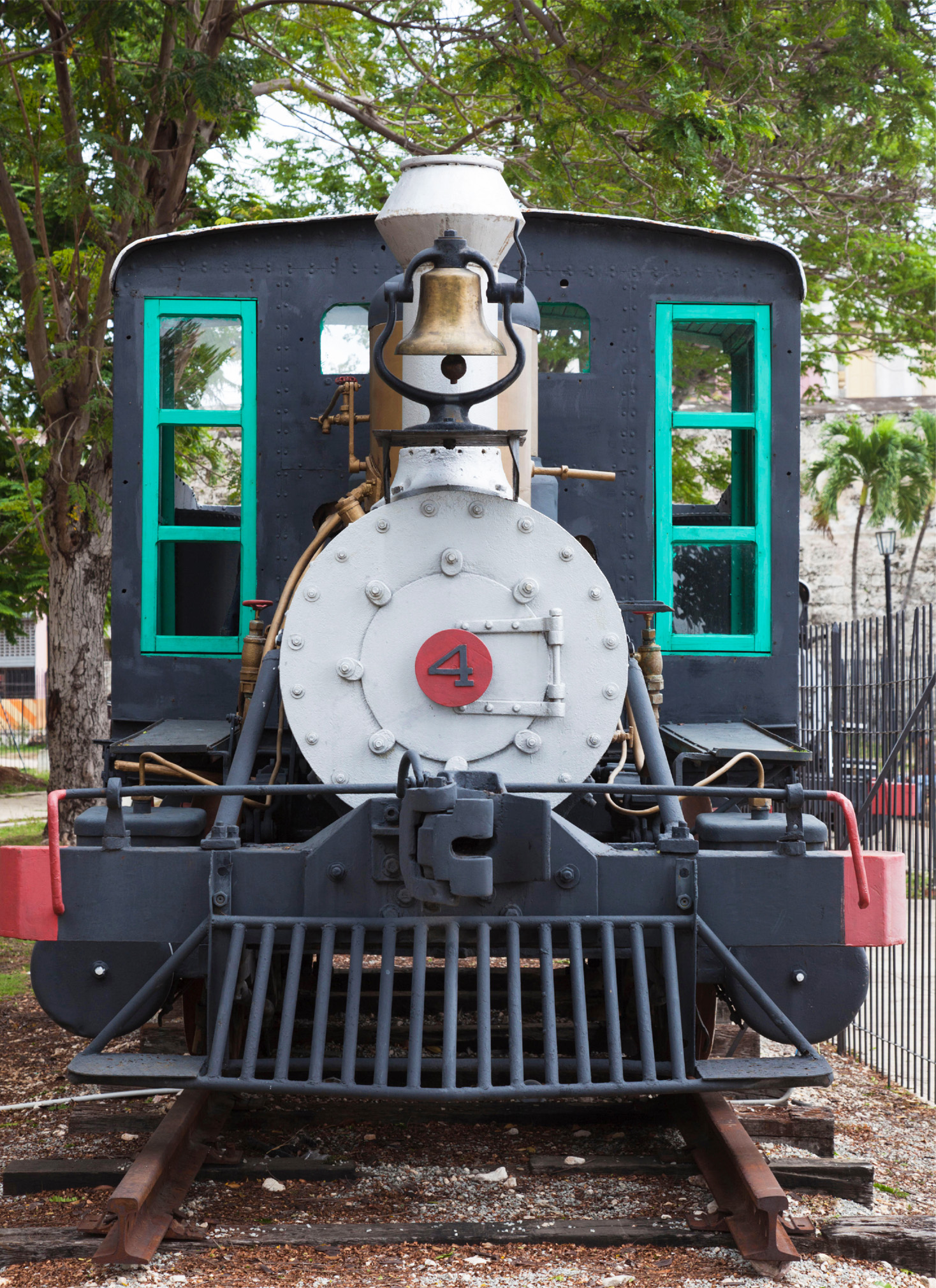
t A vintage steam train in a park on Avenida del Bélgica
Experience La Habana Vieja
|
DRINK Bar Dos Hermanos This harbourfront bar was one of writer Ernest Hemingway’s favourite drinking spots. The cocktails, still as good as they were in the writer’s day, and live music make a visit worthwhile. W3 ⌂ Avenida del Puerto, 305 § 7861 3514 El Chanchullero An immensely popular bohemian hole-in-the-wall on Plaza del Cristo, serving mouth-watering tapas dishes and killer cocktails. U3 ⌂ Calle Brasil ∑ el-chanchullero.cm Dulcería Bianchini This tiny Swiss-run café makes excellent cappuccinos and other coffees, as well as cakes. There’s another branch at Calle Sol 12. W3 ⌂ Callejón del Chorro # 7862 8477 |
